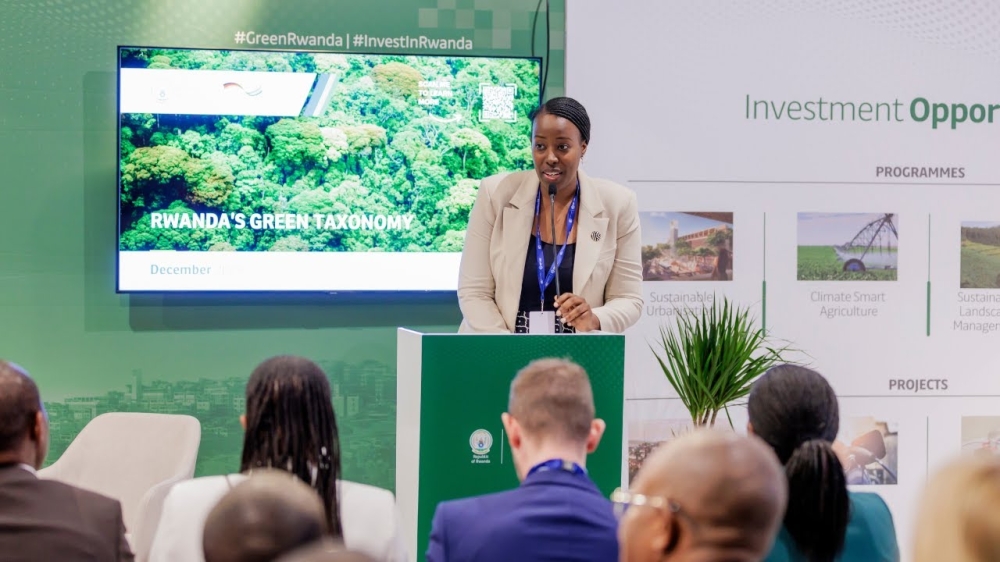

The cabinet on April 17 approved Rwanda&039;s Green Taxonomy, a policy framework that aligns public and private sector investments with national environmental and climate priorities.
The programme seeks to promote and facilitate green finance by standardising green project guidelines to align investments with environmental goals.
ALSO READ: Private sector key in driving green growth –AfDB report
Relatively new all over the world, a Green Taxonomy is a classification system that defines which economic activities and assets are considered "green" or sustainable.
It aims to guide investment towards environmentally sustainable projects, prevent greenwashing – an attempt to make people believe that a company is doing more to protect the environment than it is, and ensure transparency in environmental disclosures.
In Rwanda, the Green Taxonomy was developed in phases, focusing initially on key sectors like agriculture, construction, transport, and energy.
Pursuing green growth and investment
According to an explanatory note by the Ministry of Finance and Economic Planning, Rwanda is pursuing a green growth approach to development and requires an estimated $11 billion to achieve the goals outlined in the country’s 2030 Climate Action Plan, known as the Nationally Determined Contributions (NDCs) under the Paris Agreement.
ALSO READ: ‘Blended finance’ could boost green investments in Rwanda
The explanatory note states that attracting this level of investment, from both the public and private sectors, requires a clear definition of "sustainable.”
This is intended to instil confidence in Rwanda’s green investment opportunities.
ALSO READ: Rwanda faces $7 billion funding gap to implement climate action plan
"To enable this and promote green investment, Rwanda is developing a Green Taxonomy—a policy instrument that provides clear, relevant and actionable guidance for the market. The framework aims to define sustainability criteria, foster a common understanding, build trust and prevent greenwashing. In doing so, it is expected to unlock substantial green investments, contributing to Rwanda's vision of becoming a climate-resilient and carbon-neutral economy by 2050."
Preventing greenwashing
Preventing greenwashing under this framework means addressing the practice whereby companies or organisations falsely claim to be environmentally friendly in order to attract environmentally conscious consumers or improve their public image.
ALSO READ: Rwanda enters tripartite deal to cooperate on Article 6 carbon credit projects
Discouraging greenwashing shifts the focus towards genuine action, encouraging companies to adopt meaningful, measurable and verifiable sustainability practices.
Governments and watchdog agencies will play a crucial role in establishing guidelines and legal frameworks to penalise false or exaggerated environmental claims.
Ensuring ESG reporting
The framework will ensure that Environmental, Social, and Governance (ESG) reporting is comprehensive and timely. In today’s business environment, ESG reporting has become a vital tool for assessing a company’s non-financial performance and its impact on people and the planet.
Comprehensive ESG reporting means that companies must provide a complete, in-depth overview of their ESG performance, which includes environmental factors such as carbon emissions, energy use, water consumption, waste management, biodiversity impact, and climate risk.
Prioritised sectors
Rwanda’s Green Taxonomy will provide a solid foundation for the country’s green transformation, the creation of new industries, and efforts to position Rwanda as the sustainable finance hub of East Africa, according to the ministry of finance.
ALSO READ: Rwanda revises green growth strategy
It is the second taxonomy in Africa (after South Africa) and the first on the continent to include the agricultural sector.
It also serves as an innovative framework to include activities that contribute to climate change adaptation and resilience. The taxonomy was developed in phases. The first phase included four key economic sectors: agriculture, construction, transport and energy, all of which significantly contribute to either climate change mitigation or adaptation.
ALSO READ: Rwanda needs $13bn to boost green transport sector
Other sectors include livestock, forestry, waste management, manufacturing, water management and environmental restoration. For climate change mitigation, a total of 60 activities were identified across major sectors of the economy with the greatest potential to reduce greenhouse gas emissions.
For climate change adaptation and resilience, over 400 measures and activities have been outlined.
Who will use Rwanda's Green Taxonomy, and how?
Rwanda's Green Taxonomy will be used by various stakeholders and in a range of ways. It will be used by policymakers, banks and financial institutions, investors, regulators, issuers of green bonds, and the general public.
ALSO READ: Prime Energy lists inaugural green bond on Rwanda Stock Exchange
For banks and financial institutions, the taxonomy facilitates quicker identification of sustainability-aligned investments, thereby reducing transaction costs. It also allows financial firms to restructure their product offerings to appeal to sustainability-conscious investors.
Regulators benefit from the taxonomy as it supports environmental compliance and offers a benchmark for monitoring progress towards sustainability targets.
For issuers of green bonds, the taxonomy adds credibility and legitimacy, making it easier to attract investment and build investor trust. Investors gain access to transparent and standardised information, helping to reduce information gaps and enhance decision-making. It also helps to mitigate climate-related financial risks and promote sustainable long-term investments.
Society, as a whole, benefits as the taxonomy supports the shift towards a low-carbon, sustainable and resilient economy, fostering green economic growth, job creation, and a reduction in environmental impact.
Possible application venues
The taxonomy may be applied in areas such as development and revision of national policies, fulfilment of international climate obligations, setting standards for green bonds and loans, disclosure regulations for sustainability reporting, green budget tagging, insurance and management of environmental risks as well as development of new green financial products for the stock market.


